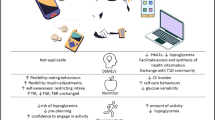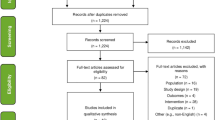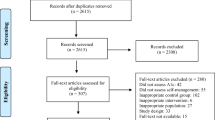Abstract
Providing behavioral, biomarker, or disease risk feedback to patients is a key component of most behavioral interventions in diabetes, but it remains unclear what is necessary for such feedback to be truly engaging and effective. We sought to identify how personalized health-related feedback is most effectively designed and delivered, and how feedback may be tailored to meet the needs of individual patients with diabetes. To do so, we systematically reviewed recent findings concerning the effectiveness of feedback in eight health-related areas, including several specific to diabetes care (blood glucose monitoring and HbA1c) and others which touch on broader care dimensions (blood pressure, cholesterol, dietary intake, pedometer usage, self-weighing, and medical imaging). Five interdependent characteristics of health-related feedback were identified (clarity of the feedback message, personal meaningfulness of the feedback, frequency of feedback, guidance and support accompanying feedback, and interplay between feedback and patient characteristics) and applications for use in diabetes care were provided. Findings suggested that feedback will be most effective when it is easy for patients to understand and is personally meaningful, frequency of feedback is appropriate to the characteristics of the behavior/biomarker, guidance for using feedback is provided, and feedback is qualified by patient characteristics. We suggest that the effectiveness of feedback to promote better diabetes outcomes requires careful consideration of the feedback message, how it is delivered, and characteristics of the recipients.

Similar content being viewed by others
References
Papers of particular interest, published recently, have been highlighted as: • Of importance
McClure JB. Are biomarkers a useful aid in smoking cessation? A review and analysis of the literature. Behav Med. 2001;27:37–47.
Cappuccio FP, Kerry SM, Forbes L. Blood pressure control by home monitoring: meta-analysis of randomized trials. BMJ. 2004;329:145–51.
Wing RR, Phelan S. Long-term weight loss maintenance. Am J Clin Nutr. 2005;82:222–5.
Ford AL, Bergh C, Sabin MA, Hollinghurst S, Hunt LP, Shield JP. Treatment of childhood obesity by retraining eating behavior: randomized controlled trial. BMJ. 2010;340:5388–92.
Fitzsimons CF, Baker G, Gray SR, Nimmo MA, Mutrie N. Does physical activity counseling enhance the effects of a pedometer-based intervention over the long-term: 12-month findings from the Walking for Wellbeing in the West Study. BMJ Public Health. 2012;12:206–18.
Hollands GJ, Hankins M, Marteau TM. Visual feedback of individual’s medical imaging results for changing health behavior. Cochrane Database Systematic Reviews 2010.
DiClemente CC, Marinilli AS, SIngh M, Bellino LE. The role of feedback in the process of health behavior change. Am J Health Behav. 2001;25:217–27.
Conroy MB, Kyeongra Y, Elci OU, Gabriel KP, Styn MA, Wang J, et al. Physical activity self-monitoring and weight loss: 6-month results of the SMART Trial. Med Sci Sports Exerc. 2011;43:1568–74.
Carver CS, Scheier MF. Control theory: a useful conceptual framework for personality-social, clinical and health psychology. Psychol Bull. 1982;92:111–35.
Kanfer FH, Duerfeldt PH. Motivational properties of self-reinforcement. Elmsford: Pergamon Press; 1990.
Bize R, Burnand B, Mueller Y, Comuz J. Biomedical risk assessments as an aid for smoking cessation. Cochrane Database Syst Rev. 2005;4, CD004705.
Agarwal R, Bills JE, Hecht TJ, Light RP. Role of home blood pressure monitoring in overcoming therapeutic inertia and improving hypertension control: a systematic review and meta-analysis. Hypertension. 2011;57:29–38.
Marquez-Contreras E, Martell-Claros N, Gil-Guillen V, Figuera-Von M, Casado-Martinez J. Efficacy of a home blood pressure monitoring programme on therapeutic compliance in hypertension: the EAPACUM-HTA study. J Hypertens. 2006;24:169–75.
Vrijens B, Goetghebeur E. Comparing compliance patterns between randomized treatments. Controlled Clin Trials. 1997;18:187–203.
Ogedegbe G, Schoenthaler A. A systematic review of the effects of home blood pressure monitoring on medication adherence. J Clin Hypertens. 2006;8:176–81.
Onzenoort HA, Verberk WJ, Kroon AA, Kessels AG, Nelemans PJ, van der Kuy PM, et al. Effect of self-measurement of blood pressure on adherence to treatment in patients with mild-to-moderate hypertension. J Hypertens. 2010;28:622–7.
Staessen JA, Hond ED, Celis H, Fagard R, Keary L, Vanderhoven G, et al. Antihypertensive treatment based on blood pressure management at home or in the physician’s office: a randomized controlled trial. JAMA. 2004;291:955–64.
Mahler H, Kulik J, Gerrard M, Gibbons F. Long-term effects of appearance-based interventions on sun protection behaviors. Health Psychol. 2007;26:350–60.
Chapin RB, Williams DC, Adair RF. Diabetes control improved when inner-city patients received graphic feedback about glycosylated hemoglobin levels. J Gen Intern Med. 2003;18:120–4.
Levetan CS, Dawn KR, Robbins DC, Ratner RE. Impact of computer-generated personalized goals on HbA1C. Diabetes Care. 2002;25:2–8.
O’Connor PJ, Sperl-Hillen J, Johnson PE, Rush WA, Crain AL. Customized feedback to patients and providers failed to improve safety or quality of diabetes care. Diabetes Care. 2009;32:1158–63.
Sherifali D, Greb JL, AMirthavasar G, Hunt D, Haynes RB, Harper W, et al. Effect of computer-generated tailored feedback on glycemic control in people with diabetes in the community. Diabetes Care. 2011;34:1794–8.
Bravata DM, Smith-Spangler C, Sundaram V, Gienger AL, Lin N, Lewis R, et al. Using pedometers to increase physical activity and improve health. JAMA. 2007;298:2296–304.
Tudor-Locke C, Lutes L. Why do pedometers work? A reflection upon the factors related to successfully increasing physical activity. Sports Med. 2009;39:981–93.
Tudor-Locke C, Corbin CB. Taking steps toward increased physical activity; using pedometers to measure and motivate. Pres Counc Phys Fit Sports. 2002;3:1–8.
Kabutoya T, Ishikawa J, Hoshide S, Eguchi K, Shimada K, Kario K. A home blood pressure monitor equipped with a graphic function facilitates faster blood pressure control than conventional home blood pressure monitor. J Clin Hypertens. 2009;11:422–5.
Dowray S, Swartz JJ, Braxton D, Viera AJ. Potential effect of physical activity based menu labels on the calorie content of selected fast food meals. Appetite. 2013;62:173–81.
Polonsky WH, Fisher L. Right answer, but wrong question: SMBG can be clinically valuable for non-insulin users. Diabetes Care 2012;35.
Parkes G, Greenhalgh T, Griffen M, Dent T. Effect on smoking quit rate of telling patients their lung age: the Step 2 quit randomized controlled trial. BMJ 2008.
Schultz PW, Nolan JM, Cialdini RB, Goldstein NJ, Griskevicius V. The constructive, destructive and reconstructive power of social norms. Psychol Sci. 2007;18:429–34.
Rees G, Lamoureux EL, Nicolaou TE, Hodgson LA, Weinman J, Speight J. Feedback of personal retinal images appears to have a motivational impact in people with non-proliferative diabetic retinopathy and suboptimal HbA1C: findings of a pilot study. Diabetic Med. 2013;30:1122–5. In this small but intriguing pilot study, T1D patients with non-proliferative retinopathy who were exposed to personal retinal images demonstrated greater improvement in glycemic control than control patients over a 3-month period.
Gibbons F, Gerrard M, Lane DJ, Mahler H, Kulik J. Using UV photography to reduce use of tanning booths: a test of cognitive mediation. Health Psychol. 2005;24:358–63.
Shahab L, Hall S, Marteau T. Showing smokers with vascular disease images of the arteries to motivate cessation: a pilot study. Br J Health Psychol. 2007;12:275–83.
Polonsky WH, Fisher L, Hessler DH, Edelman SV. What is so tough about self-monitoring of blood glucose? Perceived obstacles among patients with type 2 diabetes. Diabet Med. 2014;31:40–6. Three key obstacles to self-monitoring of blood glucose were identified—Burden, Avoidance, and Pointlessness. Higher levels of Avoidance and Pointlessness, but not Burden, were associated with less frequent self-monitoring use.
Wilson TD, Dunn DS, Kraft D, Lisle DJ. Introspection, attitude change and attitude-behavior consistency: the disruptive effects of explaining why we feel the way we do. In: Berkowitz L, editor. Advances in social psychology. New York: Academic Press; 1989. p. p. 287–343.
Parkin CG, Hinnen D, Campbell RK, Geil P, Tetrick DL, Polonsky WH. Effective use of paired testing in type 2 diabetes: practical applications in clinical practice. Diabetes Educ. 2009;35:915–27.
Polonsky WH, Skinner CS. Perceived treatment efficacy: an overlooked opportunity in diabetes care. Clin Diabet. 2010;28:89–92.
Richardson CR, Newton TL, Abraham JJ, Sen A, Jimbo M, Swartz AM. A meta-analysis of pedometer-based walking interventions and weight loss. Ann Fam Med. 2008;6:69–77.
Cagliero E, Levina EV, Nathan DM. Immediate feedback of HbA1C levels improves glycemic control in type 1 and insulin-dependent type 2 diabetic patients. Diabetes Care. 1999;22:1785–9.
Sheridan SL, Viera AJ, Krantz MJ, Ice CL, Steinman LE, Peters KE, et al. The effect of giving global risk information to adults: a systematic review. Arch Intern Med. 2010;170:230–9.
Casazza KBA, Astrup A, Bertz F, Baum C, Brown MB, et al. Weighing the evidence of common beliefs in obesity research. Crit Rev Food Sci Nutr. 2014. doi:10.1080/10408398.2014.922044.
Linde JA, Jeffery RW, French SA, Pronk NP, Boyle RG. Self-weighing in weight gain prevention and weight loss trials. Ann Behav Med. 2005;30:210–6.
Karter AJ, Parker MM, Moffet HH, Spence MM, Chan J, Ettner SL. Longitudinal study of new and prevalent use of self-monitoring of blood glucose. Diabetes Care. 2006;29:1757–63.
Schutt M, Kern W, Krause U, Busch P, Dapp A. Is the frequency of self-monitoring of blood glucose related to long-term metabolic control? Multicenter analysis including 24,500 patients from 191 centers in Germany and Austria. Clin Endocrinol Diabetes. 2006;114:384–8.
Group JDRFCGMS. Continuous glucose monitoring and intensive treatment of type 1 diabetes. N Engl J Med. 2008;359:1464–76.
Jakicic JM, Winters C, Lang W. Effect of exercise duration and intensity on weight loss in overweight, sedentary women: a randomized trial. JAMA. 2003;1999:1323–30.
Shay LE, Seibert D, Watts D, Sbrocco T, Pagliara C. Adherence and weight loss outcomes associated with food-exercise diary preference in a military weight management program. Eat Behav. 2009;10:220–7.
Baker G, Mutrie N, Lowry R. Using pedometers as motivational tools: are goals set in steps more effective than goals set in minutes for increased walking? J Health Promot Educ. 2008;46:21–6.
Fung CS, Wong WC, Wong CK, Lee A, Lam CL. Home blood pressure monitoring: a trial on the effect of a structured education program. Aust Fam Physician. 2013;42:233–8.
Uhlig K, Balk EM, Patel K, Ip S, Kitsios GD, Obadab NO, Haynes SM, Rao M, Chang L, Gaylor J, Iovin RC: Self-measured blood pressure monitoring: comparative effectiveness. In Effective health care program: comparative effectiveness review. Rockville, MD, AHRQ, 2012.
Pomerleau J, Lock K, Knai C, McKee M. Interventions designed to increase adult fruit and vegetable intake can be effective: a systematic review of the literature. J Nutr. 2005;135:2486–95.
Franciosi M, Lucisano G, Pellegrini F, Cantarello A, Consoli A, Cucco L. ROSES: role of self-monitoring of blood glucose and intensive education in patients with type 2 diabetes not receiving insulin: a pilot randomized clinical trial. Diabet Med. 2011;21:999–106.
Duran A, Martin P, Runkle I, Perez N, Abad R, Fernandedz M, et al. Benefits of self-monitoring of blood glucose in the management of new-onset type 2 diabetes mellitus: The St Carlos Study, a prospective randomized clinic-based interventional study with parallel groups. J Diabet. 2010;2:203–11.
Shaw R, Fenwick E, Baker G, McAdam C, Fitzsimons CF, Mutrie N. “Pedometers cost buttons”: the feasibility of implementing a pedometer-based walking programme within the community. BMC Public Health. 2011;11:200–8.
Logan AG, Dunai A, Mclassac WJ, Irvine MJ, Tisler A. Attitudes of primary care physicians and their patients about home blood pressure monitoring in Ontario. J Hypertens. 2008;26:446–52.
Bancej CM, Campbell N, McKay DW, Nichol M, Walker RL, Kaczorowski J. Home blood pressure monitoring among Canadian adults with hypertension: results from the 2009 survey on Living with Chronic Diseases in Canada. Can J Cardiol. 2010;26:152–7.
Levetan CS, Dawn KR, Murray JF, Popma JJ, Ratner RE, Robbins DC. Impact of computer-generated personalized goals on cholesterol lowering. Value Health. 2005;8:639–46.
Polonsky WH, Hessler DH. What are the quality of life-related benefits and losses associated with real-time continuous glucose monitoring? A survey of current users. Diabetes Technol Ther. 2013;15:295–301. Diabetes-specific QOL benefits resulting from RT-CGM were found to be common; those benefits were associated with satisfaction with device accuracy and usability and trust in one’s ability to use RT-CGM data, suggesting that “perceived efficacy,” for both device and self, are key QOL determinants.
Heisler M, Bouknight RR, Hayward RA, Smith DM, Kerr EA. The relative importance of physician communication, participatory decision making, and patient understanding in diabetes self-management. J Gen Intern Med. 2000;17:243–52.
Murray E, Burns J, See TS, Lai R, Nazareth I. Interactive health communication applications for people with chronic disease. Cochrane Database Syst Rev. 2005;4, CD004274.
Bosworth HB, Olsen MK, Oddone EZ. Improving blood pressure control by tailored feedback to patients and clinicians. Am Heart J. 2005;149:795–803.
Krueter MW, Skinner CS. Tailoring: what’s in a name? Health Educ Res. 2000;15:1–4.
Gonzalez JS, Fisher L, Polonsky WJ. Depression in diabetes: have we been missing something important? Diabetes Care. 2011;34:236–9.
Fisher L, Hessler DH, Masharani U, Stryker LA. The impact of baseline patient characteristics on interventions to reduce diabetes distress: the role of personal conscientiousness and diabetes self-efficacy. Diabetic Med. 2014;31:739–46.
Burke LE, Wang J, Sevick MA. Self-monitoring in weight loss: a systematic review of the literature. J Am Diet Assoc. 2011;111:92–102.
Butcher Z, Fairclough S, Stratton G, Richardson D. The effect of feedback and information on children’s pedometer step counts at school. Pediatr Exerc Sci. 2007;19:29–38.
Chamberlain J, Dopita D, Gilgen E. Persistence of continuous glucose monitoring use in a community setting one year after purchase. Clin Diabetes. 2013;31:106–9.
Polonsky WH, Fisher L, Schikman C, Hinnen D, Parkin C, Jelovsky Z, et al. Structured self-monitoring of blood glucose significantly reduces A1C levels in poorly controlled, noninsulin-treated type 2 diabetes: results from the Structured Testing Program study. Diabetes Care. 2011;34:262–7.
Fisher L, Dickinson WP. New technologies to support self-management support in diabetes: not just a bunch of cool apps. Diabetes Care. 2011;34:240–3.
Acknowledgments
This research was funded by an unrestricted educational grant from Abbott Diabetes Care.
The authors gratefully acknowledge the contributions of the following colleagues in the preparation of this manuscript: Jeffrey S. Gonzales, PhD; Linda Gonder-Frederick, PhD; Richard A. Jackson, MD; Julie A. Wagner, PhD; and John D. Piette, PhD.
Compliance with Ethics Guidelines
ᅟ
Conflict of Interest
William H. Polonsky has served as a consultant for Roche Diabetes Care, Abbott Diabetes Care, Johnson & Johnson Diabetes Care, Dexcom, Eli Lilly, Novo Nordisk, Sanofi Diabetes, and Takeda. Lawrence Fisher has served as a consultant for Roche Diabetes Care, Abbott Diabetes Care, and Eli Lilly.
Human and Animal Rights and Informed Consent
This article does not contain any studies with human or animal subjects performed by any of the authors.
Author information
Authors and Affiliations
Corresponding author
Additional information
This article is part of the Topical Collection on Psychosocial Aspects
Rights and permissions
About this article
Cite this article
Polonsky, W.H., Fisher, L. When Does Personalized Feedback Make A Difference? A Narrative Review of Recent Findings and Their Implications for Promoting Better Diabetes Self-Care. Curr Diab Rep 15, 50 (2015). https://doi.org/10.1007/s11892-015-0620-7
Published:
DOI: https://doi.org/10.1007/s11892-015-0620-7




